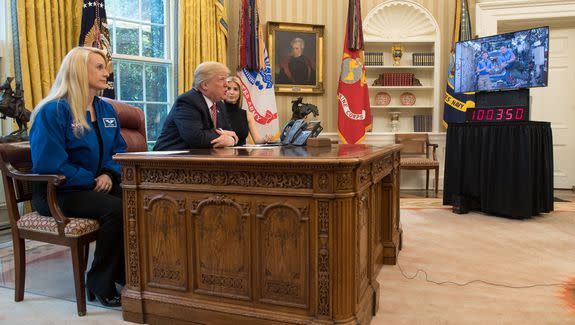Donald Trump asked astronauts in space a question only he can answer

President Donald Trump called up to the International Space Station on Monday to congratulate NASA astronaut Peggy Whitson on her record-breaking spaceflight.
Trump used some of his time speaking with Whitson and her fellow crewmember Jack Fischer to talk about the military and the inspiration that space brings to kids watching the long-distance video call around the country.
But he also asked a revealing, and unsettling, question.
SEE ALSO: Take that, dudes: Female astronaut breaks record for most time spent in space.
Instead of announcing his pick for NASA administrator (we're still waiting...) or revealing more about what he's planning for space policy in the next four years, Trump used part of his time to ask Whitson and Fischer a question only he, as president, can answer [emphasis added]:
"Tell me, Mars — what do you see a timing for actually sending humans to Mars? Is there a schedule? And when would you see that happening?"
Whitson — who just broke the record for most time in space for any U.S. astronaut — managed to answer the question as best as she could.
"Well, I think as your bill directed, it will be approximately in the 2030s," Whitson said. Since she's a pro, Whitson managed to get in a pitch for NASA funding, too.
"...Unfortunately, spaceflight takes a lot of time and money, so getting there will require some international cooperation to get it to be a planet-wide approach in order to make it successful, just because it is a very expensive endeavor."
The fact is, Whitson, Fischer, and all of their fellow NASA astronauts aren't the ones who get to decide when, or even if, we'll get to Mars.
That decision is made by people in political positions, like, I don't know, the president of the United States.
It wasn't an astronaut that addressed Congress in 1961 and set a target of making it to the moon by the end of that decade, it was then-president John F. Kennedy.
Presidents and lawmakers set the agenda for NASA, and depending on their priorities, the space agency's directives can swing wildly from administration to administration.
At the moment, NASA doesn't have a whole lot of direction.
A bipartisan bill that Trump recently signed into law directs NASA to get to Mars by the 2030s, but it doesn't allocate any funding for that goal. Only a budget, which has yet to be fully proposed, can do that.
During the call, Trump also suggested that we should accelerate the timeline for getting astronauts to Mars.
"Well, we want to try and do it during my first term or, at worst, during my second term," Trump said during the call. "So we'll have to speed that up a little bit, okay?"

Image: NASA/Bill Ingalls
Even though Trump was trying to crack a joke, he hit upon one of the major problems with a huge, decades-long endeavor like sending humans to the red planet.
Politicians tend to be more interested in making grand gestures and proclamations about the glory of America's space program than actually funding those huge visions.
Without allocating significant amounts of funding for a crewed trip to Mars, that kind of high-risk spaceflight won't happen on the current timeline, much less an accelerated one.
The whims of new administrations have thrown America's space program into turmoil on more than one occasion.
It is one of those rides that you hope never ends. I am so grateful for all those who helped me on each of my missions! #LifeInSpace pic.twitter.com/msjKSg6WWH
— Peggy Whitson (@AstroPeggy) April 23, 2017
Former president George W. Bush directed NASA to go back to the moon with his expensive Constellation program, so NASA got to work on it.
After years of working toward that goal, the Obama administration came in and dismantled it, effectively wasting billions of dollars in development costs due to the change in administration.
Trump may have already killed one Obama-era NASA program.
His administration's budget blueprint directs NASA to stop development of its mission to redirect an asteroid into orbit around the moon for astronauts to visit it.
That mission never had much congressional support, but even so, it's a good illustration of just how easy it is for NASA's goalposts to change without much notice.
